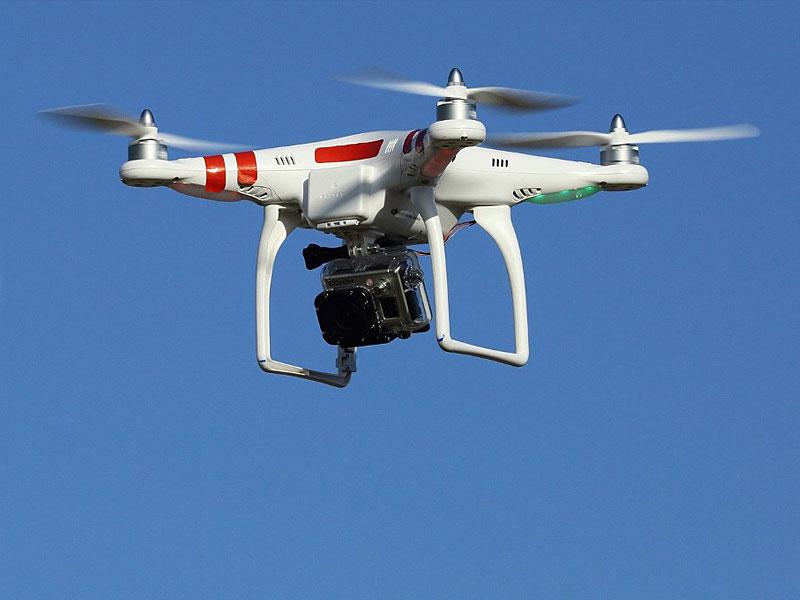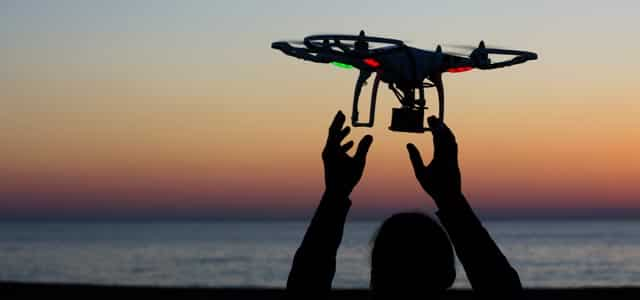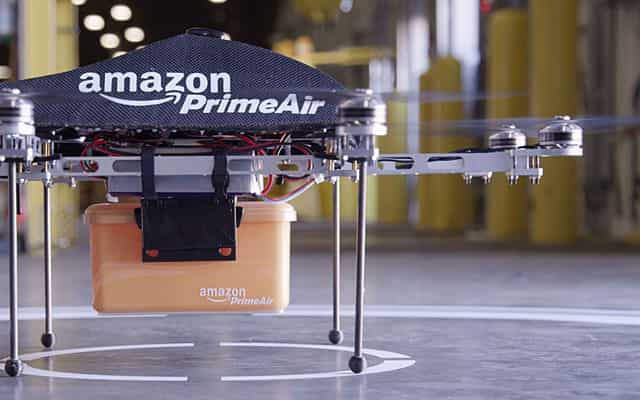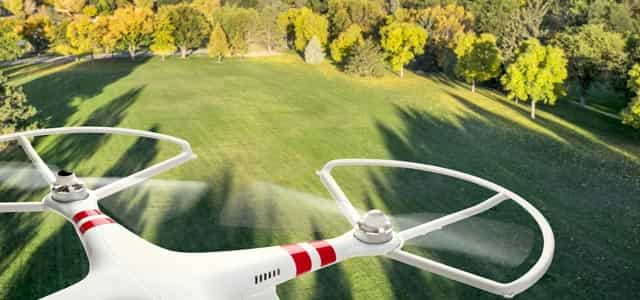Something in the air: Drones finally making a comeback to Indian skies
Now that the government is considering replacing a knee-jerk ban with a set of regulations, drones are making a comeback to Indian skies.

One morning in early February, Aakash Sinha, the CEO of Omnipresent, a New Delhi-based robotics company, had a rather strange request from a group of professors at a private university: Could his company build a drone that would deliver a gold medal on stage at their convocation ceremony?
Sure, it was a gimmick. But it wasn't especially difficult. After all, Omnipresent's custom-designed drones had been used by the Delhi Police last year when riots had broken out in Trilokpuri in East Delhi to spot 70 bags of bricks that were to be used as projectiles, a large amount of weapons, and bottles of acid; it had worked with the DRDO to hash out a plan to use drones at the border; and it was working with a major medical college in New Delhi to prototype air ambulances to send medicines to remote areas where no cars can reach. Delivering a medal through the air a few hundred feet away? Easy.
And yet, Sinha had a few concerns: what would happen if a medal hanging from a drone somehow unbalanced it mid-flight, for instance, and how close could you fly a drone with rotors spinning at 12,000 rotations per minute to someone for them to take down the medal safely.
Still, it was a cool assignment. Less consequential than delivering first-aid kits, perhaps, but more, well, fun. And so, Sinha said yes, he could, indeed make a drone that could pull off some gimmickry.


******
Gimmickry is, indeed, what propelled commercial drones to the forefront of public consciousness. At the end of 2013, Amazon CEO Jeff Bezos took CBS correspondent Charlie Rose into a secret room at Amazon's Seattle headquarters and showed him the company's latest plan: 30-minute deliveries using drones.
"I know it looks like science fiction," Bezos told Rose. "It's not."
The project, called Prime Air, seemed revolutionary, but was widely panned. Popular Science was sceptical. Gizmodo called it "truly revolutionary [marketing]". Still, the idea that you could, potentially, place an order online and have a quadcopter chuck it through your window or drop it on your porch was exciting.
In May 2014, Mumbai's Francesco's Pizzeria released a YouTube video which showed a drone delivering a pizza to a high-rise in Worli. It turned out later that the video was simply a promotion —no actual pizza was delivered. Still, it didn't stop the Mumbai police from demanding an explanation. They also asked Air Traffic Control at the Mumbai International Airport whether the pizzeria had sought permission for its experiment.
Francesco's refused to comment on the incident, but one imagines that its defence would have been simple: there were no guidelines that prevented people from flying unmanned aerial vehicles in Indian airspace. Francesco's wasn't doing anything illegal?—?it was simply playing with technology that others in the country and around the world had already been experimenting with.
Just a month earlier, Headlines Today had used drones to shoot panoramic views of crowds gathered at key constituencies such as Varanasi, Amethi, Vadnagar and Muzaffarnagar at the height of the election season; the Panna Tiger Reserve in Madhya Pradesh had tested them to keep track of both tigers and poachers; and even as thousands died in the worst floods in Uttarakhand in five decades, the National Disaster Management Authority had used four unmanned aerial vehicles to scan areas that were impossible for rescue workers to reach. Drones, it turned out, were capable of more than just gimmicks. Even wedding photographers were using them to get sweeping, romantic aerial footage as bride and groom walked down the aisle.
In October 2014, the Indian government did what it does best: it banned drones. The Director General of Civil Aviation (DGCA) issued a stern public notice in the first week of October citing "security threats" as the reason why no one could fly drones in Indian airspace till further notice. It states:
Clearly, no wedding photographer was going to go through that much red tape for a few pretty pictures.
Also read: Drones with high-definition cameras, the new-age wedding photographers
It was a blow both to businesses that were interested in using drones and operators that provided these services. Airpix, a Mumbai-based company with high-profile clients like Reliance Energy had to shut down its flagship aerial photography service after the DGCA notice. Line, a production company that used drones for aerial photography for Karan Johar's Dharma Productions among others, had to stop using the devices. Housing.com, a residential property-listings website, which introduced aerial photography in January 2014, had to cancel the feature.
"We lost close to 60 percent of our customers since the ban came into effect," says Anirudh Gupta, President of Business Insights at Funaster, a five-year-old company based in New Delhi that assembles and sells drones. "Earlier, 90 percent of the inquiries we got translated into sales. Now, it's about 30. People back out once they hear about the regulations."
Yes, the ban was disappointing, says John Livingstone, a former Navy officer who specialised in flying Herons?—?massive, military-grade unmanned aerial vehicles used by the Armed Forces for surveillance. "But we were happy that by banning drones, the DGCA at least acknowledged the existence of a civilian drone industry in the country!"
Also see: On a budget or got thousands to spend, there's a drone out there for you
Livingstone retired from the Navy last year to embark on a bunch of projects: He started a magazine called Unmanned, an industry publication aimed at UAV makers, paramilitary forces, the Indian Armed Forces, defence personnel and drone hobbyists; he founded Johnette, a technology company that makes drone accessories like charging pads; and he became President of the Consortium of Unmanned Vehicle Systems India, an industry lobby he founded to give a platform to all stakeholders in the Indian drone industry, which, he estimates, is potentially worth billions.
Weeks after the ban, Johnette held a conference about the future of unmanned systems in India where officials from the DGCA and the Ministry of Civil Aviation were peppered with questions from Indian drone manufacturers: What do you mean we can't fly drones? What about the millions of rupees we've invested in this market? How soon can we have some regulations in place?
"The officials had no answers," says Livingstone.


Unhappy with the lack of information, members of the Consortium — Livingstone won't say how many there are — put together a document that they submitted to the DGCA to help the regulator formulate guidelines for drone usage in India at the end of last year. The 28-page proposal addresses how to make drones and how to fly them, how to ensure standards and certify operators, how to deal with licensing, insurance and safety, and more.
"Look, it's simple," says Livingstone, "We have the knowledge and the expertise to help them put together a framework for flying drones in India. I don't believe the DGCA even has a single, qualified UAV officer on board."
Earlier this month, the Indian Express published a report that quoted a senior DGCA official saying that the regulator would come out with a framework for civilian drone use in India in a couple of months — much sooner than anyone had ever expected. Livingstone is ecstatic and believes that there's a good chance that Consortium's document could have sped the the DGCA along.
"I'm really happy," he gushes over the phone. "Really, really happy."
The DGCA hasn't yet put out an official statement lifting the ban on drones yet but the timing of the report is no coincidence. In February, the US Federal Aviation Administration (FAA) unveiled proposed regulations for the commercial use of small drones.
Some of the key points of the new US regulations are maximum flight speed of each unmanned aircraft (100 miles an hour), maximum weight (25 kg) and maximum altitude (500 feet above ground level). Most importantly, the regulations also require that drone operators maintain a "visual line-of-sight" with each drone they fly — bad news for companies like Amazon, which was recently issued an "experimental airworthiness certificate" by the FAA after it threatened to take its operations overseas if it wasn't allowed to test its delivery drones outdoors.
After regulating that operators must maintain a visual line-of-sight with drones, the FAA recently gave Amazon permission to test its Prime Air delivery drones outdoors after the company threatened to take its business overseas.
Besides the US, Australia, New Zealand and Spain have notified provisional norms for the civilian use of UAVs. Spain is especially liberal with drone usage, allowing UAVs weighing up to 150 kg for investigations, agriculture, surveillance, aerial advertising, search and rescue operations, radio and TV transmissions, and more.
Once the DGCA comes out with its regulations — despite repeated attempts, the authority declined to comment on the proposed norms — India will be only the fifth country in the world to allow commercial drone use.


******
A few hours before the convocation ceremony at the university's sprawling, 110-acre campus kicked off, Aakash Sinha and his team of two engineers, Abhishek Chakraborty and Himank Sharma, are holed up on the second floor of the university's boys' hostel in a stuffy room that smells faintly of wet towels. John Livingstone, who had known the crew for years, has joined them for "moral support", as he puts it.
Despite the stifling heat of the unusually torrid February afternoon, Livingstone is clad in a sharp, black three-piece suit. He is pacing the room in a state of feverish excitement and is trying to calm down a nervous Chakraborty who is freaking out about flying a drone over the heads of a thousand people. "If anything goes wrong," Livingstone says boisterously, "feel free to shout at anyone including the chancellor. Remember, you are in charge here."
Designing the drone to deliver a medal had been anything but trivial. Over the last few weeks, a team of engineers at Omnipresent had hunkered down at their workbenches and modified the Garun, a 2 kg surveillance quad-copter that's capable of lifting payloads of just over 500 gm that the company makes. The medal, which clocked in at just over a 100 gm, would hang from a lightweight carbon-fiber rod attached to an actuator, a small motor that converts energy into motion. On stage, the guest of honour would simply need to touch the medal to engage the actuator and have it drop magically into their hand.
The team had done test-flights with fake medals roughly the same weight as the real one hanging from the drone, mapping out flight-paths and testing wind resistance.
"We were fairly confident, but there are always some nagging doubts," says Chakraborty. "We were especially worried because there were going to be a lot of people beneath the drone. What happens if there is an unexpected gust of strong wind or if the drone is imbalanced or if the GPS signal breaks? With electronics, you can never be a hundred percent sure of anything."


With less than an hour before the drone is scheduled to take off, the crew carries three Garuns outside the hostel to an open space about 500 yards away. ("the second one's a backup for the main drone and the third one is a backup for the backup" explains Sinha.) It's time for a final test flight.
Chakraborty strings a fake medal from the drone and sets it on the ground. He pushes a few buttons on the controller and with a series of beeps, the drone springs to life. "There's not much wind," says Livingstone, sticking his arm into the air. "Maybe six knots?"
The rotors whirr and the drone lifts off the ground. Then, it wobbles dangerously in the air and starts descending. "Back off, back off, back off!" shouts Sinha as the drone comes dangerously close to Sharma. Chakraborty finally manages to make a smooth landing. There's no time to figure out what's wrong. The team switches to the backup drone, which flies perfectly.
Also read: IIT-Kanpur scholars develop 3 hi-tech drones
By the time they are at the centre of a sea of swarming graduates in bright red convocation gowns and matching mortarboards, the sun is high in the cloudless sky. The forecast was wrong after all. Chakraborty places the jet-black Garun at his feet. It is the size of a large puppy and its arms stick out like a bizarre insect. He bends down, does some last minute adjustments, and flashes a thumbs up at Sinha.
Sixty seconds before the gold medal winner comes on stage, Chakraborty pushes a button on his controller. The drone emits three shrill beeps as it searches for a GPS signal. Then, the rotors whir noisily as the beast readies for take-off.
Quidich, an aerial photography firm, built image-processing algorithms on top of drone footage to pinpoint healthy sugarcane crop in Uttar Pradesh. Photo: Lima Pix (photo is representative)
The drones of 2015 are no longer rich man's toys. As prices steadily drop, they're becoming everyone's playthings.
"They are super efficient. Flying over something gives you a whole new perspective ," says Tanuj Bhojwani, an IIT-Bombay graduate who, in 2014, founded Quidich Technologies, an aerial photography firm that has since expanded into other drone services. "You can also send drones to places where it would be dangerous for a human to go."


Filming has been the mainstay of Quidich — its first assignment was the Headlines Today election coverage — but recently, the firm has been approached by companies that want to enlist its services for agriculture.
"A sugar manufacturing facility that sources from farmers in Uttar Pradesh wanted to know exactly when they would get their next shipment of sugarcane and how much. We took high-resolution images of vast tracts of land that would take someone on the ground weeks to cover using custom-designed drones," explains Bhojwani. The team then built image-processing algorithms on top of the aerial footage that were able to pinpoint healthy crop. They were also able to feed this information into a scheduling algorithm to figure out when exactly would the crop from each plot of land be ready for harvesting.
In a country like India where large sections of the population live in places barely accessible by regular roads, drones can also be used to deliver medicines. "It's faster and cheaper than sending an entire ambulance," says Omnipresent's Aakash Sinha.
What Sinha is excited about is drones he says will come a few years down the line. "Right now, they're not very intelligent," he says. Omnipresent is one of the companies that is working to get drones to achieve a degree of autonomy. "We're working on a system that will allow a drone flying in an oil refinery to quickly zoom into an area an record footage if a fire is detected," says Sinha. "The drone will automatically send a notification to the person in charge, who can tap on it and view live video of the fire. We can also have drones capable of face-detection doing active surveillance at the border and notifying Army officials when there's suspicious movement. They'll be like intelligent, flying CCTV cameras. Nobody will need to spend hundreds of hours watching surveillance tapes anymore."
What about deliveries, the Holy Grail of drone use cases?
"I'll never, ever say that delivering products by drone is the future, no matter how many videos Amazon releases," snaps Livingstone. "You can't have a million drones flying over a city. It's going to create noise pollution, it's going to clog air traffic. It's not practical!"
There's a long pause. Then: "Maybe in a small village that only has a hundred houses, sure. But never in Delhi or Mumbai."
Livingstone may be cynical, but e-commerce giants are already experimenting with drone deliveries in India. Last year, long before the DGCA banned drones, Amazon had approached them to test the feasibility of using drones for delivering small, lightweight items, in India. And in early 2014, online retailer Jabong, had tested using drones to zip shoes and apparel indoors through its warehouses to test drone aerodynamics.
Still, Jabong's founder and Managing Director Praveen Sinha, is a huge skeptic of using drones when it comes to actually delivering products to customers. "Getting a drone to your house is not the problem," he says. "But most Indian addresses aren't really that well-defined. A 'B-131' could be a block of multistory apartments and a drone wouldn't know which house to land at, even with GPS coordinates."
There is also the question of dealing with high-tension wires, angry birds, and the high safety risk of landing having an object with sharp propellers enter a densely populated residential area. "I don't think most safety standards will let you do that," says Sinha.


Jabong or Amazon or might never use a drone to deliver your next order straight to your terrace, but once regulations are in place, it isn't a stretch to think of them using drones to bypass Delhi's clogged roads and deliver products to a warehouse closest to you. From their, your order can simply travel the final mile to your house on the usual delivery truck.
Will the DGCA regulations allow these things? If the regulator simply apes the FAA's rather limited regulations and doesn't adapt the rules for Indian circumstances, drone deliveries might not happen any time in the near future. Civilian drone use might never take off beyond clicking dronies (that's a selfie taken by a drone — take that, selfie sticks!) or shooting some casual aerial video. And if the DGCA requires every person who flies a drone to have a license, drone adoption might not be as fast as it could be.
Still, Bhojwani says he's optimistic, because "the business case for using drones is much, much stronger than the security concerns around them. You can't really stop a good thing."
******
A cheer rises from the crowd as the Garun lifts off the ground and frames itself against a cerulean sky. Chakraborty barely hears it. As he eases the joystick forward, the drone makes a beeline for the stage straight ahead, its golden payload dangling rather stupidly below.
It lowers itself gently towards the guest of honour who reaches an arm out…and pulls hard. Instantly, the actuator, which activates only when someone touches the medal — touches, not pulls — locks up and for a moment, the Garun seems a little unsteady in the air.
From the corner of his eye, Chakraborty sees Livingstone running towards the stage, his black jacket flying behind him, mouthing "Don't pull, don't pull, don't pull!"
It's over, Chakraborty thinks. He's about to abandon ship and make a safety landing when the guest stops pulling. The actuator engages and the medal plops into his hand.
Chakraborty pulls back on the joystick. High above the crowd, the Garun cuts a swathe through scorching air and circles back to its master. For just a moment, a tiny cloud of dust blows up as it lowers itself to the ground. Then, with a sigh, it shudders to a stop.
Catch all the Latest Tech News, Mobile News, Laptop News, Gaming news, Wearables News , How To News, also keep up with us on Whatsapp channel,Twitter, Facebook, Google News, and Instagram. For our latest videos, subscribe to our YouTube channel.

























